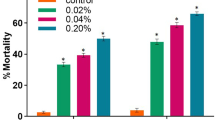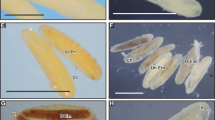Abstract
Groups of 30Xenopus laevis embryos, at “tail-bud” stage (Nieukoop-Faber stages 22–24) were exposed to 0.1–2 ppm concentrations of various pesticides for 1 to 10 days. The pesticides used were chloranil and dichlone (both are fungicidal and herbicidal); diquat (herbicide); and nabam (fungicide). The parameters examined were mortality, gross morphology, histology, and behavior. Chloranil (1.25 to 1.75 ppm) treated embryos showed abnormalities of the otolith, optic cup, and general pigmentation. Their movement was sporadically convulsive and they were unable to maintain proper balance. Dichlone (0.1 to 0.15 ppm) disrupted the development of the cephalic end of the embryo. Many of these embryos developed a slightly retarded trunk and tail only. These headless embryos lived for a time and were relatively lethargic. Diquat (0.75 to 2.0 ppm) administration reduced body size and pigmentation, and altered body shape. When embryos were treated with both 1.0 ppm of diquat and 2.0 ppm of nabam the integrity of myomeres and myocommata of the musculature was disrupted. The histological bases of these morphological and behavioral changes are discussed.
Similar content being viewed by others
References
Bancroft, R., and K. V. Prahlad: Effect of ethylenbis[dithiocarbamic acid] disodium salt (nabam) and ethylenebis [dithiocarbamato] manganese (maneb) onXenopus laevis development. Teratology7, 143 (1973).
Brown, D. D., and J. D. Caston: Biochemistry of amphibian development I, Ribosome and protein synthesis in early development ofRana pipiens. Devel. Biol.5, 412 (1962).
Cooke, J.: Properties of the primary organization field in the embryo ofXenopus laevis. V. Regulation after removal of the head organizer, in normal early gastrule and in those already possessing a second implanted organizer. J. Embryol. Exp. Morph.30, 283 (1973).
Kay, K.: Toxicology of pesticides: Recent advances. Environ. Res.6, 202 (1973).
Landauer, W., and N. Salam: Aspects of dimethyl sulfoxide as solvent for teratogens. Develop. Biol.28, 35 (1972).
Mees, G. C.: Experiments on the herbicidal action of 1,1'-ethylene-2,2'-dipyridylium dibromide. Ann. Appl. Biol.48, 601 (1960).
Menzie, C.M.: Metabolism of pesticides.Bureau of Sport Fisheries and Wildlife, Div. of Pesticide Registration. Wildlife Report No. 127 Washington, D.C. (1969).
Nieukoop, P. D., and J. Faber (eds.): Normal table ofXenopus laevis (Daudin). North Holland Publ. Co., Amsterdam (1956).
Pimentel, D.: Ecological effects of pesticides on non-target species.Executive Office of the President, Office of Science and Technology. Washington, D.C. (1971).
Prahlad, K. V., R. Bancroft, and L. Hanzely: Ultrastructural changes induced by the fungicide ethylenebis [dithiocarbamic acid] disodium salt (nabam) inXenopus laevis tissues during development. Cytobios9, 121 (1974).
Sikka, H. C., J. Saxena, and G. Zweig: Alteration in cell permeability as a mechanism of action of certain quinone pesticides. Plant Physiol.51, 363 (1973).
Rich, S.: Quinones.In:Fungicides: An Advanced Treatise, Vol. II. Chemistry and Physiology. D. C. Torgeson, ed. Academic Press, N.Y., U.S.A. and London, England, U.K. (1967–69).
van Steenis, G., and M. J. van Logten: Neurotoxic effect of the dithiocarbamate tecoram on the chick embryo. Toxicol. Appl. Pharamaocl.19, 675 (1971).
Author information
Authors and Affiliations
Rights and permissions
About this article
Cite this article
Anderson, R.J., Prahlad, K.V. The deleterious effects of fungicides and herbicides onXenopus laevis embryos. Arch. Environ. Contam. Toxicol. 4, 312–323 (1976). https://doi.org/10.1007/BF02221030
Received:
Accepted:
Issue Date:
DOI: https://doi.org/10.1007/BF02221030




